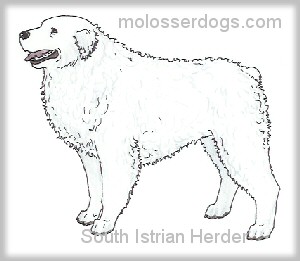South-Istrian Herder
 A breed of Antiquity, this mighty Morlach mastiff is hard to find these days. The South-Istrian Herder's roots lie in the Dinara Sheepdog, but it is believed to had been developed by crossing it with imported Hungarian, Dalmatian and Italian breeds. Through breedings with the other Balkan dogs, most notably the Tornjaks and Karst Sheepdogs, it lost some of its water-dog instincts while receiving excellent guarding and herding qualities. Thought to have close ties with the ancient Ragusa Watchdog and the Abruzzese Mastiff, the South Istrian Herder is a breed that makes an intimidating adversary to men and beasts alike. Although not as large as other Molossers, it will still gladly give its life while protecting its owner and property. Already rare before WW2, the breed has been disappearing at an alarming late in the 2nd half of the 20th century, mostly due to the lack of public interest and abandoning of livestock farms, but also because of the assimilation into a few other breeds of the region.
A breed of Antiquity, this mighty Morlach mastiff is hard to find these days. The South-Istrian Herder's roots lie in the Dinara Sheepdog, but it is believed to had been developed by crossing it with imported Hungarian, Dalmatian and Italian breeds. Through breedings with the other Balkan dogs, most notably the Tornjaks and Karst Sheepdogs, it lost some of its water-dog instincts while receiving excellent guarding and herding qualities. Thought to have close ties with the ancient Ragusa Watchdog and the Abruzzese Mastiff, the South Istrian Herder is a breed that makes an intimidating adversary to men and beasts alike. Although not as large as other Molossers, it will still gladly give its life while protecting its owner and property. Already rare before WW2, the breed has been disappearing at an alarming late in the 2nd half of the 20th century, mostly due to the lack of public interest and abandoning of livestock farms, but also because of the assimilation into a few other breeds of the region.
This breed gets lumped under the Croatian Tornjak name today, even though it's quite smaller, has a true mastiff-type head and somewhat shorter legs. The South-Istrian Herder has a hard coat, which can be straight, wavy and even curly, but the face must remain clean. There is also a very rare bearded variety, which is believed to be descended from the extinct Morlach working breed called Turko-Istrian Sheepdog. The tail of the South Istrian Herder is usually docked, but some dogs are even born bobtailed.
Although black dogs known as the Karavlach type existed in the past, the preferred coat colours for the South-Istrian Herder have been either uniform ivory or white with some black spotting, but a lot of today's dogs are multicoloured. The average height is 22 inches.
